
Pew Research Center conducted this study to understand the news media coverage of the early days of the Biden administration and Americans’ perceptions of that coverage. The Center has analyzed news coverage of the beginning of each of the five presidential administrations since President Bill Clinton in 1993. The current study is comprised of two components, an analysis of media content and a survey analysis.
The analysis of media content is based on a selection of media coverage collected from Jan. 21 to March 21, 2021. Stories were collected from television, radio, digital and print outlets and coded by a team of nine coders trained specifically for this project. The Center has also conducted similar analyses for the early months of the four prior administrations: those of Donald Trump, Barack Obama, George W. Bush and Bill Clinton. The historical comparison is conducted across a smaller universe of outlets that existed during all five study periods, representing a mix of print publications and network evening news. For more details, see the methodology.
For the survey analysis, we surveyed 12,045 U.S. adults from March 8 to 14, 2021. Everyone who completed the survey is a member of the Center’s American Trends Panel (ATP), an online survey panel that is recruited through national, random sampling of residential addresses. This way nearly all U.S. adults have a chance of selection. The survey is weighted to be representative of the U.S. adult population by gender, race, ethnicity, partisan affiliation, education and other categories. Read more about the ATP’s methodology.
See here to read more about the questions used for this report and the report’s methodology.
This is the latest report in Pew Research Center’s ongoing investigation of the state of news, information and journalism in the digital age, a research program funded by The Pew Charitable Trusts, with generous support from the John S. and James L. Knight Foundation.
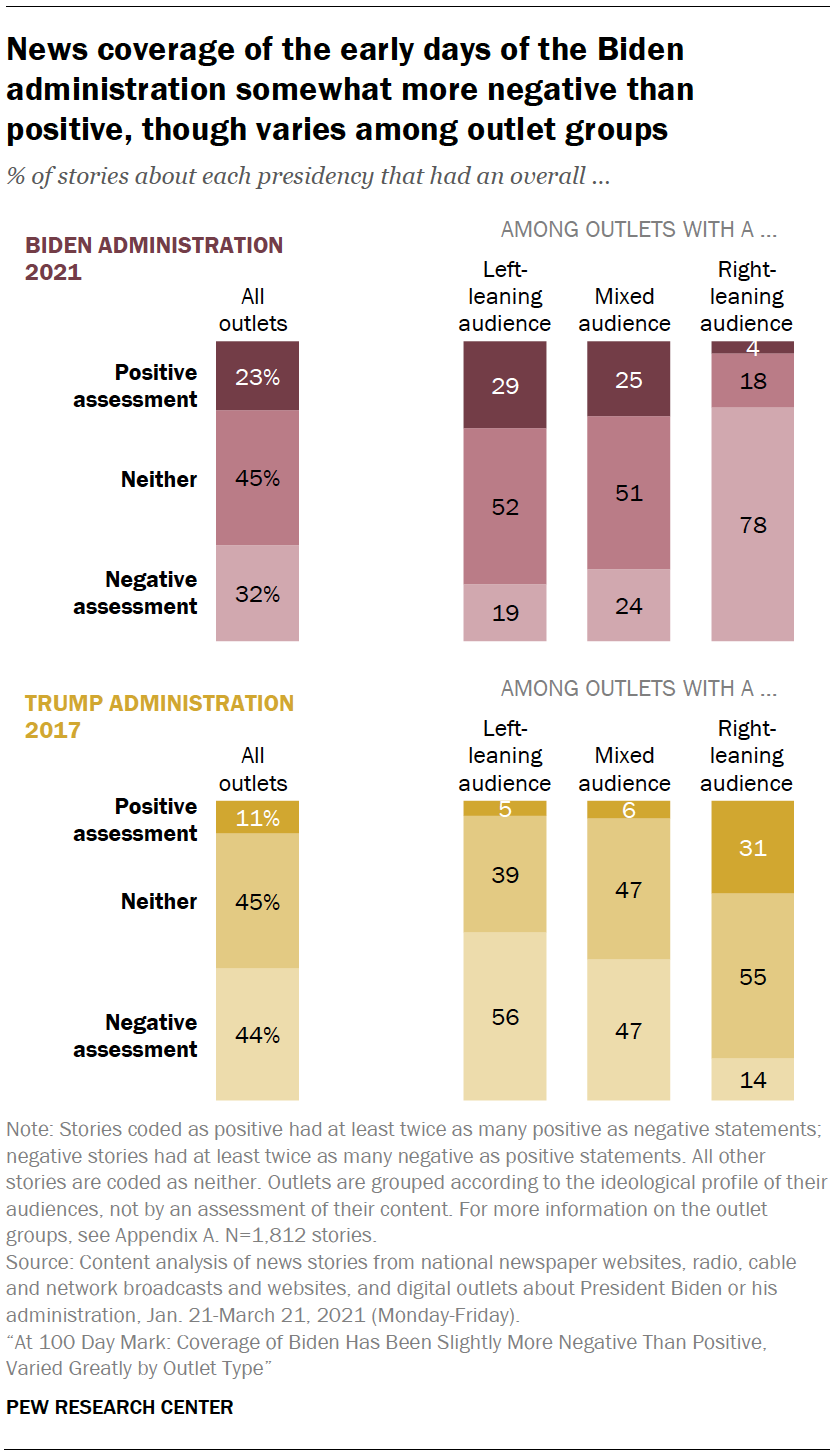 News coverage of President Joe Biden’s early days in office was modestly more negative than positive, and most of the stories were centered around his ideology and policy agenda rather than his character and leadership – a contrast with coverage of former President Donald Trump at the start of his administration, according to a new Pew Research Center study that examines media coverage of the new administration.
News coverage of President Joe Biden’s early days in office was modestly more negative than positive, and most of the stories were centered around his ideology and policy agenda rather than his character and leadership – a contrast with coverage of former President Donald Trump at the start of his administration, according to a new Pew Research Center study that examines media coverage of the new administration.
Overall, 32% of stories about the Biden administration had a negative assessment, while 23% had a positive one and 45% were neither positive nor negative. But those numbers varied widely by types of media outlets. Fully 78% of the stories from outlets with predominantly right-leaning audiences carried a negative assessment. That stands in stark contrast to the 19% of stories with a negative assessment from outlets with left-leaning audiences and about a quarter of stories (24%) from outlets with a mixed audience.
That pattern emerged in a number of different aspects of coverage of the Biden administration’s first 60 days – from the topics of stories to the sources cited in those stories. The one area where there was less divergence by media outlet group, however, was in the framing of the Biden stories. Overall, 65% of the stories were framed around the new president’s policy agenda and ideology, compared with 35% around character and leadership. And in each of the three main media groupings studied, at least 59% of the stories were oriented around policy and agenda.
That framing is dramatically different from the coverage of the first few months of the Trump administration four years earlier. Then, 74% of all stories were oriented around his character and leadership, compared with only about one-quarter (26%) framed around his ideology and policy agenda. Another significant difference in their coverage is that while the negative Biden stories modestly outnumbered the positive ones, negative stories about Trump exceeded positive ones by four-to-one.
One new element of this year’s study – in Part 2 of this report – is a survey component that measures Americans’ exposure to and sense of news coverage during this early time period, how that differs by media diet, and how it compares with the analysis of media content in Part 1. For example, while the topic of the economy was covered most heavily by outlets with a left-leaning audience, a large majority of Americans, regardless of their media diet, report hearing a lot about the passage of the economic stimulus bill in the news. At the same time, the public’s sense of news coverage of the Biden administration is more positive than the study of the news coverage reveals: 46% of U.S. adults say that the early coverage they’ve seen about the Biden administration offered mostly positive assessments, far more than the 14% who say they’ve seen mostly negative ones.
These are among the key findings of a new study of media coverage in the early days of the Biden presidency. This report includes two main elements: A content analysis of news coverage of the first 60 days of the Biden administration by 25 major news outlets, which can be compared with early coverage of the Trump administration and previous administrations dating back to 1993; and a survey of 12,045 U.S. adults conducted March 8-14, 2021, as part of the American Trends Panel. See Methodology for details.
Methodological note
This study looks at coverage of the Biden administration in two different ways: 1) studying the content published by different news organizations, and 2) asking Americans about their opinions on coverage of the administration.
For our analysis of the content published by news organizations in the early days of the Biden administration, we group news organizations by the political party and ideology of their audiences. For our analysis of Americans’ views of news coverage, we group respondents by their news media diet.

Each news outlet in this study was placed in one of three groups based on the political profile of its audience (i.e., those respondents in the survey who reported getting political news from each outlet in the past week).
- Outlets with a left-leaning audience: In these outlets’ audiences, the share of liberal Democrats is at least two-thirds larger than the share of conservative Republicans. Thirteen of the 25 outlets in this study have a left-leaning audience.
- Outlets with a right-leaning audience: In these outlets’ audiences, the share of conservative Republicans is at least two-thirds larger than the share of liberal Democrats. Six of the 25 outlets in this study have a right-leaning audience.
- Outlets with a mixed audience: These outlets’ audiences have about equal numbers of liberal Democrats and conservative Republicans (i.e., neither liberal Democrats nor conservative Republicans make up at least two-thirds more of the audience than the other). Six of the 25 outlets in this study have a mixed audience.

The survey respondents in this study are grouped according to the audience makeup of outlets they turned to for political news in the past week.
- U.S. adults whose media diets are only on the right: Respondents who only turned to outlets with right-leaning audiences
- U.S. adults whose media diets tend toward the right: Respondents who turned predominantly to outlets with right-leaning audiences
- U.S. adults whose media diets are neither left nor right: These respondents didn’t turn predominantly to either outlets with a left-leaning or right-leaning audience; either they turn to outlets with left-leaning and right-leaning audiences at roughly similar rates, or they turn only to outlets with mixed audiences
- U.S. adults whose media diets tend toward the left: Respondents who turned to predominantly to outlets with left-leaning audiences
- U.S. adults whose media diets are only on the left: Respondents who only turned to outlets with left-leaning audiences
- Respondents who didn’t turn to any of the 25 outlets.
See Appendix A for more about how these groups were created and for the breakdown of all of the outlets in this study and their audience classification.
Part 1: Study of coverage by 25 news outlets during the first 60 days of Biden administration
 There are four key metrics in examining the media’s coverage of the early days of a new administration: the topics of those stories, the assessments of the administration, and the framing and the sources used.
There are four key metrics in examining the media’s coverage of the early days of a new administration: the topics of those stories, the assessments of the administration, and the framing and the sources used.
Across the 25 news outlets studied, five broad topics accounted for two-thirds (67%) of all the coverage related to the Biden administration. The economy and health care were at the top, each accounting for about 20% of total coverage.
But the topics that outlets gave the most attention to differed based on the ideological makeup of their audience (see box). Specifically, outlets whose audiences lean to the right politically put their heaviest emphasis on immigration, which was the focus of 20% of their stories related to the Biden administration. (Americans who consume news from these outlets were also much more likely to report hearing a lot about immigration policy reform, according to the survey data.) Outlets with left-leaning or mixed audiences, on the other hand, gave greatest attention to the economy and to health care, each of which was the focus of 18% or more of stories for both media groups, while immigration amounted to 8% and 10% for each.
The COVID-19 pandemic has been such a pervasive part of recent news that its presence in coverage was measured separately. Indeed, the virus outbreak was mentioned – as a major or minor component – in 72% of all stories about the Biden administration, including nearly every health care story and 96% of all economy stories, as well as other topic areas. Outlets with right-leaning audiences had fewer stories in which COVID-19 was a major focus (meaning it was a part of half or more of the story): 29%, versus 45% of the left-leaning audience outlets and 44% in the mixed audience group. A majority of stories for all three outlets groups had at least some reference to the coronavirus.
Given the unusual circumstances of the Trump-Biden transition, with Trump still contesting the election results, it is perhaps unsurprising that Trump himself was mentioned in about half the stories about the new Biden administration. There was virtually no difference in the frequency of those mentions across outlets with left-leaning audiences (50% of stories), outlets with right-leaning audiences (47% of stories) and outlets with a mixed audience (47% of stories).
Within a news story, the statements from the sources cited as well as the reporter’s own language determine the overall assessment of the Biden administration. During these first 60 days, stories were slightly more likely to carry an overall negative assessment of the administration (32%) than a positive one (23%), though just under half were neither positive nor negative (45%).1
Outlets with right-leaning audiences presented a primarily negative view of the new Biden administration. In all, about three-quarters (78%) of their stories offered a negative assessment of the administration and its actions, with only 4% offering a positive assessment. Among outlets with a left-leaning audience, the assessment was a little more positive than negative (29% of stories vs. 19%), while 52% of stories were neither positive nor negative. In outlets with a more mixed audience, the coverage of the Biden administration was also mixed: 25% of the stories had a positive assessment, 24% had a negative one and 51% were neither positive nor negative.
One area where there is little difference across the three media groups is whether the journalist framed the story around Biden’s leadership and character or his ideology and agenda. Biden’s policy and agenda framed the majority of coverage overall (65%), including 68% of the stories from outlets with mixed audiences and 65% of stories from outlets with left-leaning audiences. Stories from outlets with right-leaning audiences were modestly less likely to be framed around ideology and agenda (59%), but that still constituted a majority of stories.
The study also catalogued the presence in each story of 13 possible types of sources. Biden and/or members of his administration were by far most likely to be cited, appearing in 82% of all stories studied – including 70% of stories in outlets with right-leaning audiences. Among the other most common types of sources were groups focused on policy issues (such as the ACLU and Susan B. Anthony List) and/or experts (such as academics), which were cited in 32% of stories, Democratic members of Congress (27%), Republican members (23%) and other journalists or media organizations (20%).
Outlets with right-leaning audiences diverged from the other media groups in some types of sources they cited in stories about the Biden administration. For example, just 17% of the stories in the right-leaning audience group used sources who are experts or members of issue groups, compared with 31% of stories in the mixed-audience outlets and 39% of stories in the left-leaning group. At the same time, the outlets with right-leaning audiences were much more likely to cite other journalists and media outlets (35% of stories, versus 17% of stories from outlets with left-leaning audiences and 15% in mixed-audience outlets).
How early news coverage of Biden compares with coverage of Trump in 2017
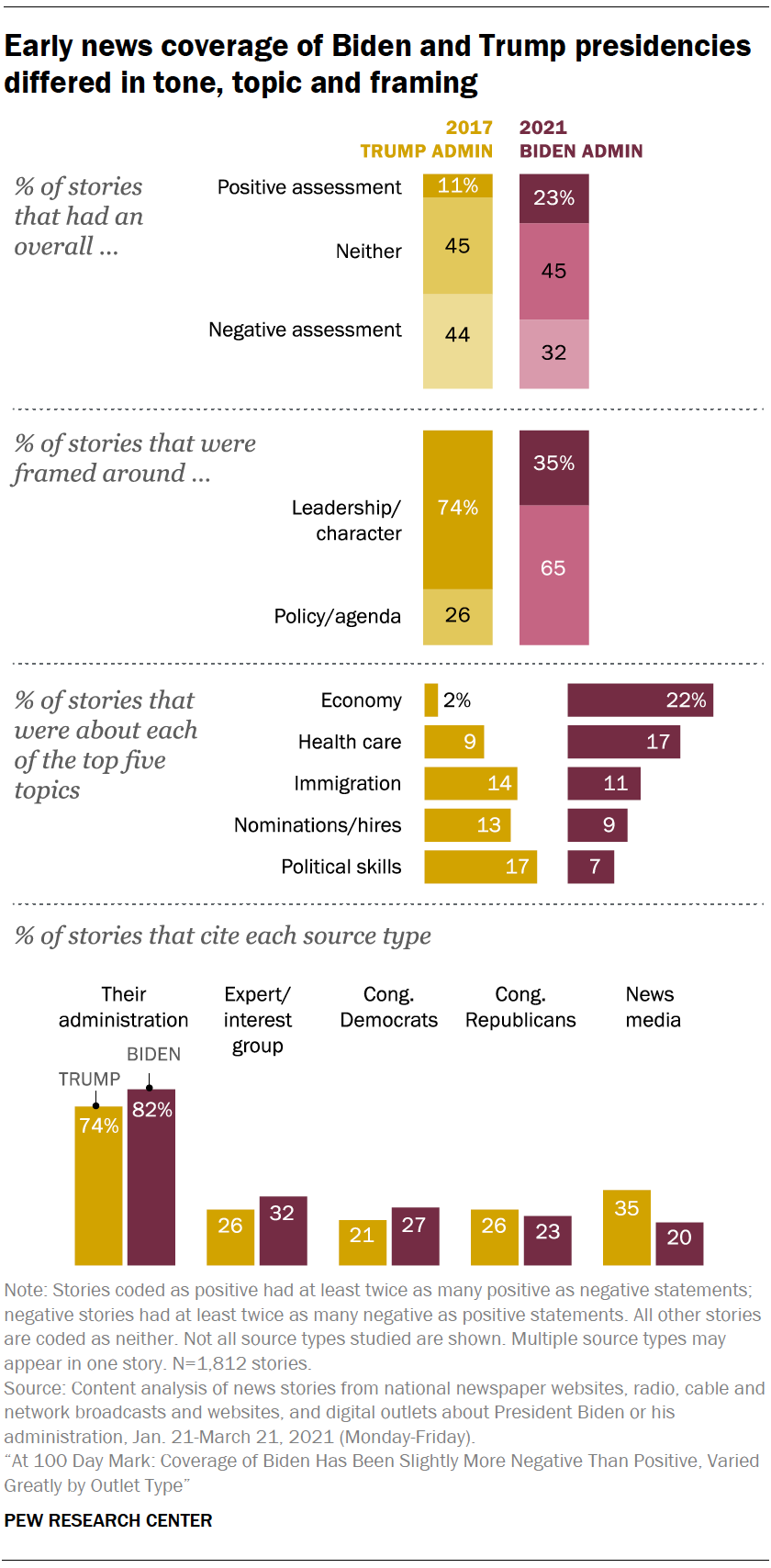 Pew Research Center has studied news coverage of the start of each new administration since 1993, when Bill Clinton began his presidency. While the structure of the analysis and specific outlets studied have evolved with the media landscape (an abbreviated long-term trend can be found here), the 2017 study of news coverage of the early days of the Trump presidency and this 2021 study of Biden are very similar in methodology, allowing for a direct comparison of most measures.
Pew Research Center has studied news coverage of the start of each new administration since 1993, when Bill Clinton began his presidency. While the structure of the analysis and specific outlets studied have evolved with the media landscape (an abbreviated long-term trend can be found here), the 2017 study of news coverage of the early days of the Trump presidency and this 2021 study of Biden are very similar in methodology, allowing for a direct comparison of most measures.
One difference to note in the Trump-Biden comparison is that the 2017 study covered the first 100 days of the administration, while this year’s study covers only the first 60 days. Still, a comparison of the 2017 data for the full 100 days and the first 60 days found only minimal percentage differences and no changes in the overall findings (see Appendix B for details.)
Four of the same subjects were among the top five most covered topics in the first months of both the Trump administration in 2017 and the Biden administration in 2021: health care, presidential appointees, immigration and political skills. U.S.-Russia relations was a leading topic in 2017, but not in 2021, while the economy was the leading 2021 topic but not among the top five in 2017. One other key difference was that in 2017 the new president’s political skills was the most covered topic, while it ranked fifth in 2021.
When it comes to the tone of coverage, both new administrations received more negative assessments than positive assessments of their activities. But while the percentage of Biden stories with an overall negative assessment (32%) modestly outnumbered the share with positive assessments (23%), stories with negative assessments of Trump outnumbered those with positive assessments by four-to-one (44% to 11%). The same share of stories about each president were neither positive nor negative (45% for both Biden and Trump).
Another stark difference in the early coverage of the Biden and Trump administrations was in how stories were framed. About two-thirds of Biden stories (65%) were framed around ideology and agenda, while about one-third (35%) focused on leadership and character. With Trump, the numbers were roughly reversed, with 74% framed around leadership and character and 26% around policy and ideology.
One similarity in coverage of the two most recent administrations has been the main source cited in news stories: Just as the Trump administration was by far the most cited source in news stories soon after Trump became president (cited in 74% of stories), so is the Biden administration the most cited source now (82%). Among other types of sources, though, there were some shifts in the rate at which they made their way into stories.
Long-term news coverage trend
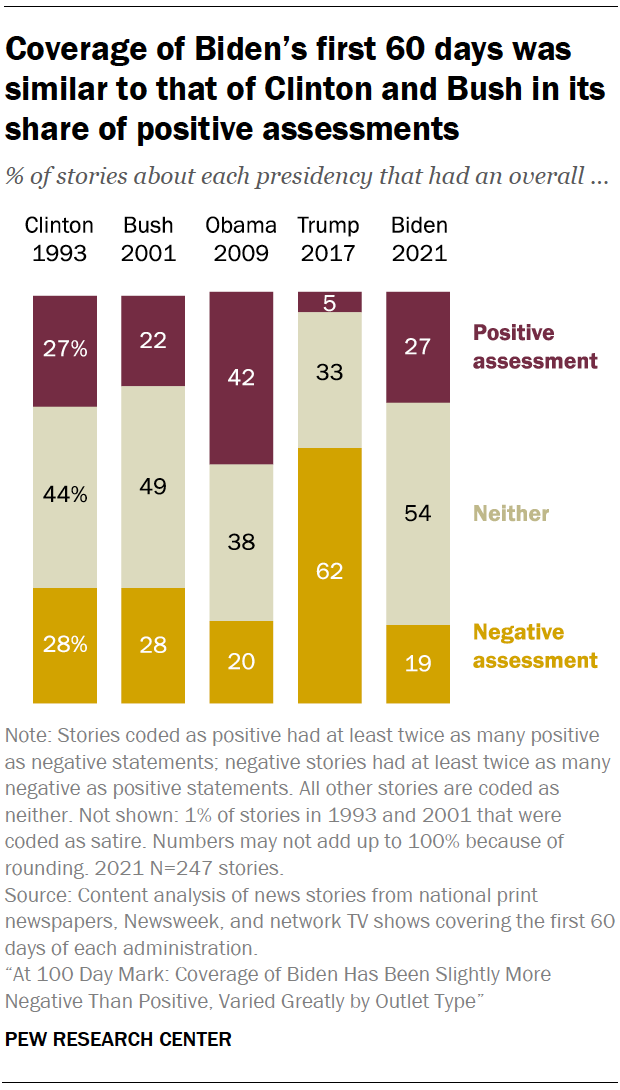 While the media landscape has changed dramatically since Clinton’s presidential inauguration, the Center has been able to conduct a long-term comparison for each of the recent administrations across a smaller subset of outlets and variables.2
While the media landscape has changed dramatically since Clinton’s presidential inauguration, the Center has been able to conduct a long-term comparison for each of the recent administrations across a smaller subset of outlets and variables.2
This year’s analysis finds that coverage of the Biden administration in this smaller sample of news outlets was more likely to carry neither a positive nor a negative assessment compared with the first 60 days of the Trump, Obama, Bush and Clinton administrations. The level of positive coverage was roughly on par with that of George W. Bush and Bill Clinton, but lower than for Barack Obama – with all four higher than Trump. Additionally, coverage of the early days of the Biden administration focused more on policy and agenda over leadership qualities than any other administration except for Bush.
Part 2: Survey of U.S. adults’ views of news coverage of the Biden administration
In addition to the analysis of the media coverage of the early days of the Biden administration, this project, for the first time, includes a survey component designed to study Americans’ sense of the news coverage of the new administration based on their different media diets.
To do this, the survey of 12,045 U.S. adults conducted March 8-14, 2021, on Pew Research Center’s American Trends Panel, asked respondents to indicate whether they got political news in the past week from each of 25 national news outlets (the same outlets as in the content study – see Appendix A for details). People were then organized into five media diet groups based on the audience of the outlets they frequent.
 Overall, about one-in-five U.S. adults (22%) said that at the time of the survey they had been following news about Biden very closely, with another 44% following it fairly closely. But attention varied across the media groups, with Americans who turn only to outlets with left-leaning audiences least likely to be following news about the Biden administration very closely (16%) – and their counterparts on the right almost twice as likely to do so (30%).
Overall, about one-in-five U.S. adults (22%) said that at the time of the survey they had been following news about Biden very closely, with another 44% following it fairly closely. But attention varied across the media groups, with Americans who turn only to outlets with left-leaning audiences least likely to be following news about the Biden administration very closely (16%) – and their counterparts on the right almost twice as likely to do so (30%).
The survey also asked how much Americans had heard about each of seven specific efforts and initiatives of the new administration. Passage of the economic stimulus bill and the distribution of the COVID-19 vaccine topped the list, with nearly eight-in-ten U.S. adults (77%) saying they had heard a lot about the stimulus package and 74% hearing a lot about vaccine distribution. This aligns with the content analysis, which found that the economy and health care were the two leading topics for the period studied (see Chapter 1).
Roughly half of U.S. adults (52%) said they had heard a lot about Biden’s use of executive orders to reverse many Trump administration policies. Fewer had heard a lot about the other topics mentioned, such as the pursuit of talks with Iran (just 10% said they had heard a lot).
Americans who get news only from outlets with right-leaning audiences were most likely to say they had heard a lot about Biden’s use of executive orders (79%), nearly twice the share among those who turn only to outlets with left-leaning audiences (42%). This right-oriented group was also about twice as likely as the left-oriented group to have heard a lot about immigration reform efforts (45% vs. 21%).
Vaccine distribution was the one storyline the groups with media diets on the left or tending left had heard considerably more about than the right-only or tend-right groups. Again, the broader topic of health care was covered slightly more by outlets with a left-leaning and a more mixed audience, the content analysis found.
In looking at how the exposure to news stories lines up with the topics that received more or less coverage in Part 1, the two storylines Americans were most likely to have heard a lot about – passage of the economic stimulus bill and the distribution of the vaccine – align with the two topic areas to receive the most coverage: the economy and health care.
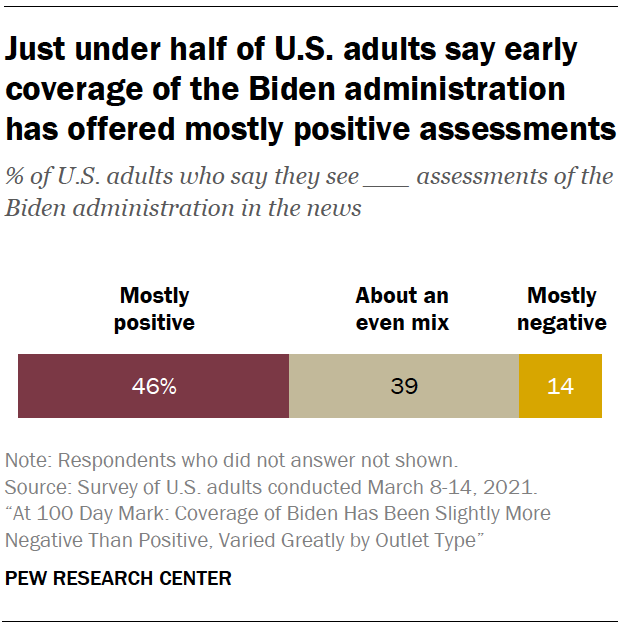 Some nuances emerge, though, within people’s media diets. While the topic of the economy was covered more by outlets with a left-leaning audience, a large majority of Americans, regardless of their media diet, report hearing a lot about the passage of the economic stimulus bill in the news.
Some nuances emerge, though, within people’s media diets. While the topic of the economy was covered more by outlets with a left-leaning audience, a large majority of Americans, regardless of their media diet, report hearing a lot about the passage of the economic stimulus bill in the news.
Americans’ sense of the early coverage about the Biden administration tends to be more positive than the tone of the content that was studied. Overall, just under half of U.S. adults (46%) say that the early coverage they’ve seen about the Biden administration has offered mostly positive assessments, while far fewer – 14% – say the news they’ve come across has given mostly negative assessments. About four-in-ten (39%) say the assessments have been about an even mix of positive and negative.
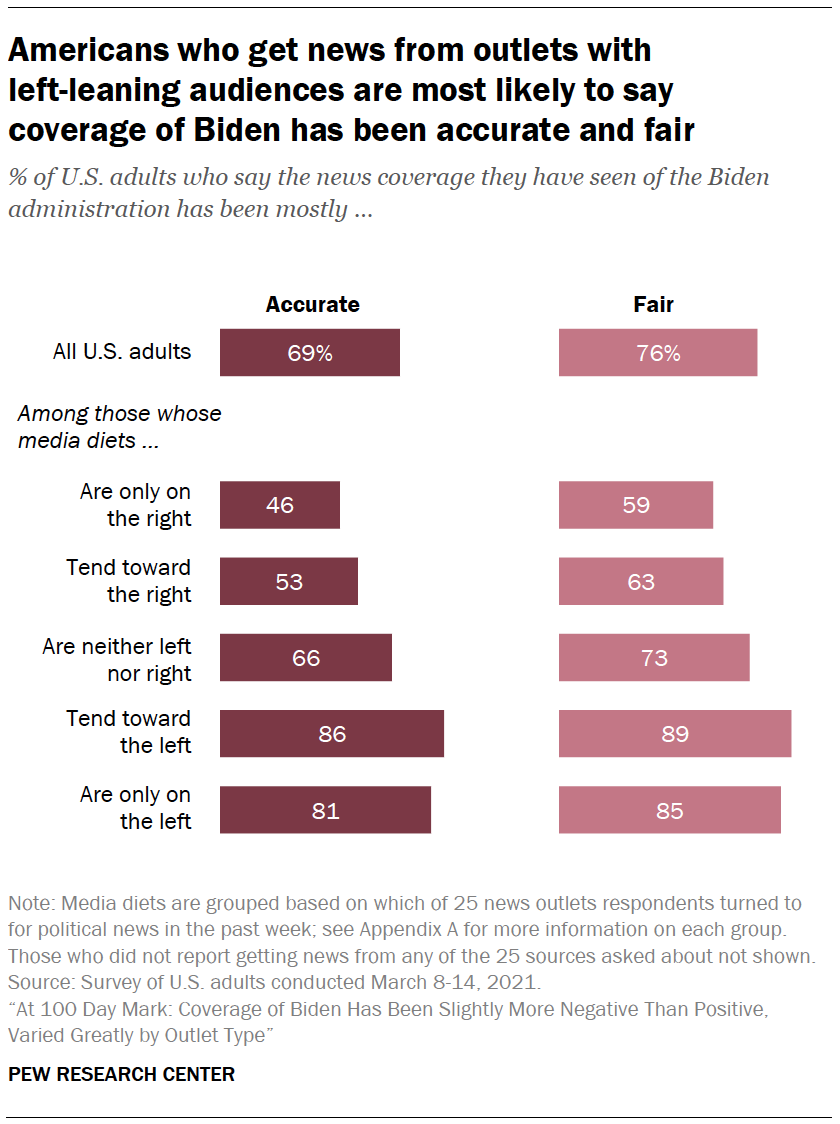
However, just as in the coverage studied, U.S. adults in the right-only and tend-right diets are most likely to say it has been mainly negative (35% and 32%, respectively, versus 6% of the left-only group and 4% of the tend-left group).
Most also say the coverage has been largely fair rather than unfair (76% vs. 21%) and accurate rather than inaccurate (69% vs. 26%). Again, however, Americans who get their news from sources with right-leaning audiences are more likely than others to say that the overall coverage they’ve seen of the Biden administration has been unfair and inaccurate. Still, a majority in the right-only media group say it is fair, and just under half say it is accurate (see Chapter 2 for details).
Which of Biden’s efforts are getting too much coverage, and which too little?
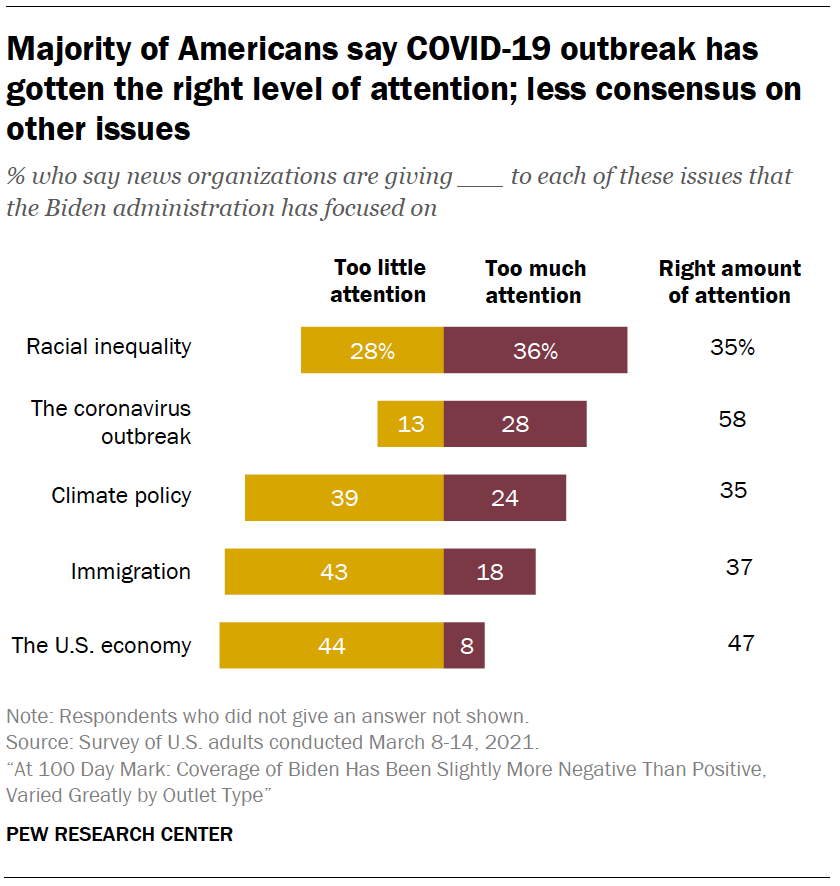 When asked whether five key priorities of the new administration were getting too much attention, too little attention or the right amount of coverage, only one such topic – the COVID-19 pandemic – was identified by a majority of Americans (58%) as getting the right amount. Racial inequality is the topic that the highest percentage of Americans say is getting too much attention (36%), though the sense overall is divided, with 28% saying the issue is getting too little attention and 35% saying the level of coverage given to racial inequality is about right.3
When asked whether five key priorities of the new administration were getting too much attention, too little attention or the right amount of coverage, only one such topic – the COVID-19 pandemic – was identified by a majority of Americans (58%) as getting the right amount. Racial inequality is the topic that the highest percentage of Americans say is getting too much attention (36%), though the sense overall is divided, with 28% saying the issue is getting too little attention and 35% saying the level of coverage given to racial inequality is about right.3
The economy and immigration are the topics with the highest shares saying they are not getting enough attention (44% and 43%, respectively).
Three-quarters of those who get their news only from outlets with right-leaning audiences say the subject of racial equality gets too much attention, far more than among those with a mixed-audience media diet (41%) and a left-only diet (13%). Also, by significant margins, those in the right-only group are likeliest to say climate policy (64%) and the COVID-19 pandemic (57%) are getting too much attention.
The survey also asked Americans which of these five issues is getting the most attention from their main news sources (rather than the news media overall).
Those who get political news only from outlets with right-leaning audiences vary – about a third (34%) say they see their news sources covering immigration the most, 27% say this of the coronavirus outbreak and 21% say the U.S. economy gets the most coverage from their sources.
For those with media diets only on the left, nearly two-thirds (64%) say the coronavirus is the most covered of the five topics. People in this left-only group are much less likely than those on the right to name immigration as the topic getting the most attention (5% vs. 34%). Americans in the mixed media group are also most likely to say the pandemic is getting the most attention from their main news sources (53%), with the economy next at 21%.
The areas of coverage people say they are getting most of from their main sources broadly align with the share of coverage devoted to each in Part 1. The coronavirus was very prevalent throughout coverage in the outlets with left-leaning and mixed audiences, with the economy as the top specific topic area. And among the outlets with right-leaning audiences, immigration was the most covered topic area.
Americans’ knowledge of key news events varies
The survey also assessed Americans’ awareness of the news by asking five fact-based questions related to issues early in the Biden administration. Two of the questions were correctly answered by large majorities of Americans: a question about the proposed increased national minimum wage (81% correctly answered $15 an hour) and a question about the number of doses required for the COVID-19 vaccines approved in the U.S. (69% correctly answered that the number of doses required varies depending on the vaccine).4
Americans were less likely to answer the other three questions correctly. Roughly half (49%) knew that the administration has both reentered the Paris agreement and rescinded construction permits for the Keystone XL pipeline, 43% correctly said that the administration has stopped federal funding for the border wall but not ordered that the wall be dismantled, and 33% knew at the time of the survey that the Biden administration was meeting its goal of vaccinating 1 million Americans per day.
Terminology for elements of news coverage studied
This study examined how the news media covered the first 60 days of President Biden and his administration from Jan. 21 through March 21, 2021. Researchers coded stories from the 25 news outlets – with content pulled from more than 45 specific programs or websites – for a number of measures:
Topic: News stories were first coded as being about one of 47 specific topics or storylines (the most prominent topic within each story was coded as the story’s overall topic). These topics and storylines were in turn grouped into three broad topic categories, in addition to an “other” category:
- Domestic issues
- Foreign affairs and
- The president’s management and political approach.
Frame: When reporting a story about a specific topic, there are various frames that journalists can use to orient the narrative. This study classified stories into one of two main frames (whichever accounted for more than 50% of the story):
- Leadership and character or
- Core ideology and policy agenda.
For example, an article or segment about health care could be framed around the legislative differences in what the administration is proposing versus members of Congress (thus coded as core ideology and policy agenda). Or, such a story could be framed around the evaluation of the president in terms of his outreach to and relationship with members of Congress, which would then be coded as leadership and character.
Source types: The study also measured 13 different types of sources that might be cited in a story:
- Biden or a member of the administration
- A Biden family member (not in the administration)
- A congressional Democrat
- A congressional Republican
- A state or local official
- A foreign official
- Donald Trump, his family or former administration
- An issue-based group or expert
- Businesses and corporations
- A poll
- A journalist (other than the reporter or anchor of the story) or news organization
- A citizen and
- Anonymous or unnamed sources.
This measure identifies the presence of a type of source in any given article, not the total number of individual sources. There could be more than one source within any source category, such as quotes from two members of the administration. There may also have been sources used outside the types listed above that were not captured in this study.
Assessment of the Biden administration: In this analysis, each statement in a story (made by a source or the reporter him or herself) was analyzed to determine how, if at all, it assessed President Biden and his administration’s actions or words. Within a story, there needed to be at least twice as many positive as negative statements for a story to be considered positive and vice versa to be considered negative. If this threshold was not met, stories were coded as neither positive nor negative.
COVID-19 focus: In this study, each story was assessed for the extent to which COVID-19 was mentioned as part of the story. This was measured separately from topic since COVID is so intertwined with many of the other topic areas and captures whether COVID-19 was a major part of the story (meaning at least half the story addressed it), a minor part of the story (addressed in less than half the story), or not a part of the story at all.
Trump mention: Each story was analyzed for whether former President Donald Trump was mentioned. This includes all mentions of him, but not of other individuals such as his family members and former administration members or of references to his administration broadly.


